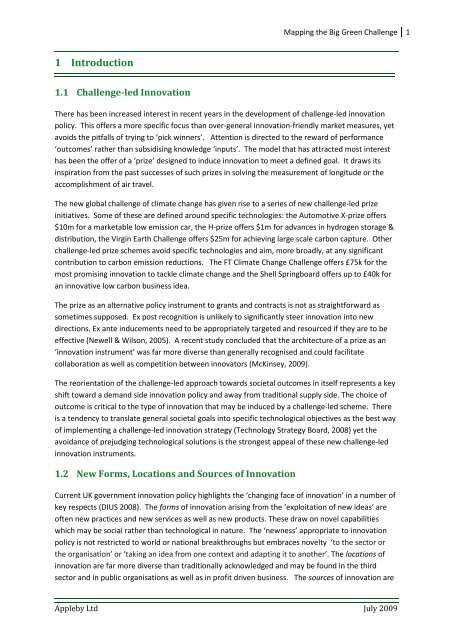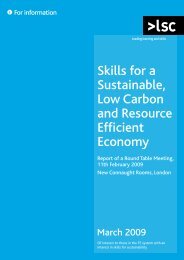Mapping the Big Green Challenge - The Skills & Learning ...
Mapping the Big Green Challenge - The Skills & Learning ...
Mapping the Big Green Challenge - The Skills & Learning ...
Create successful ePaper yourself
Turn your PDF publications into a flip-book with our unique Google optimized e-Paper software.
<strong>Mapping</strong> <strong>the</strong> <strong>Big</strong> <strong>Green</strong> <strong>Challenge</strong> 11 Introduction1.1 <strong>Challenge</strong>-led Innovation<strong>The</strong>re has been increased interest in recent years in <strong>the</strong> development of challenge-led innovationpolicy. This offers a more specific focus than over-general innovation-friendly market measures, yetavoids <strong>the</strong> pitfalls of trying to ‘pick winners’. Attention is directed to <strong>the</strong> reward of performance‘outcomes’ ra<strong>the</strong>r than subsidising knowledge ‘inputs’. <strong>The</strong> model that has attracted most interesthas been <strong>the</strong> offer of a ‘prize’ designed to induce innovation to meet a defined goal. It draws itsinspiration from <strong>the</strong> past successes of such prizes in solving <strong>the</strong> measurement of longitude or <strong>the</strong>accomplishment of air travel.<strong>The</strong> new global challenge of climate change has given rise to a series of new challenge-led prizeinitiatives. Some of <strong>the</strong>se are defined around specific technologies: <strong>the</strong> Automotive X-prize offers$10m for a marketable low emission car, <strong>the</strong> H-prize offers $1m for advances in hydrogen storage &distribution, <strong>the</strong> Virgin Earth <strong>Challenge</strong> offers $25m for achieving large scale carbon capture. O<strong>the</strong>rchallenge-led prize schemes avoid specific technologies and aim, more broadly, at any significantcontribution to carbon emission reductions. <strong>The</strong> FT Climate Change <strong>Challenge</strong> offers £75k for <strong>the</strong>most promising innovation to tackle climate change and <strong>the</strong> Shell Springboard offers up to £40k foran innovative low carbon business idea.<strong>The</strong> prize as an alternative policy instrument to grants and contracts is not as straightforward assometimes supposed. Ex post recognition is unlikely to significantly steer innovation into newdirections. Ex ante inducements need to be appropriately targeted and resourced if <strong>the</strong>y are to beeffective (Newell & Wilson, 2005). A recent study concluded that <strong>the</strong> architecture of a prize as an‘innovation instrument’ was far more diverse than generally recognised and could facilitatecollaboration as well as competition between innovators (McKinsey, 2009).<strong>The</strong> reorientation of <strong>the</strong> challenge-led approach towards societal outcomes in itself represents a keyshift toward a demand side innovation policy and away from traditional supply side. <strong>The</strong> choice ofoutcome is critical to <strong>the</strong> type of innovation that may be induced by a challenge-led scheme. <strong>The</strong>reis a tendency to translate general societal goals into specific technological objectives as <strong>the</strong> best wayof implementing a challenge-led innovation strategy (Technology Strategy Board, 2008) yet <strong>the</strong>avoidance of prejudging technological solutions is <strong>the</strong> strongest appeal of <strong>the</strong>se new challenge-ledinnovation instruments.1.2 New Forms, Locations and Sources of InnovationCurrent UK government innovation policy highlights <strong>the</strong> ‘changing face of innovation’ in a number ofkey respects (DIUS 2008). <strong>The</strong> forms of innovation arising from <strong>the</strong> ‘exploitation of new ideas’ areoften new practices and new services as well as new products. <strong>The</strong>se draw on novel capabilitieswhich may be social ra<strong>the</strong>r than technological in nature. <strong>The</strong> ‘newness’ appropriate to innovationpolicy is not restricted to world or national breakthroughs but embraces novelty ‘to <strong>the</strong> sector or<strong>the</strong> organisation’ or ‘taking an idea from one context and adapting it to ano<strong>the</strong>r’. <strong>The</strong> locations ofinnovation are far more diverse than traditionally acknowledged and may be found in <strong>the</strong> thirdsector and in public organisations as well as in profit driven business. <strong>The</strong> sources of innovation areAppleby Ltd July 2009











